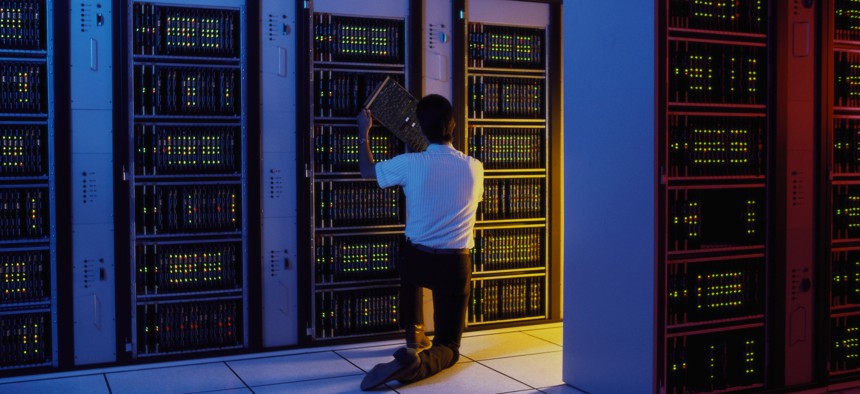State leaders count up modernization wins

Steve Chenn/Getty Images
Tech leaders say gains in system processing speeds, security and customer experience make the case for modernization.
When Amy Pechacek became Wisconsin’s secretary of workforce development in September 2020, the state was in the throes of COVID-19 and crushed by a backlog of unemployment insurance claims.
The Department of Workforce Development, or DWD, faced 770,000 unprocessed UI claims, and even with three times as many employees working on those claims, progress was painfully slow.
One issue was the 50-year-old mainframe technology used to process claims was unable to deal with the 225,000% increase in cases. Meanwhile, applicants could only mail or fax their supporting documents to the state, and fraudulent claims were being approved.
But the pandemic provided a great opportunity to modernize, especially as the department waived many UI administrative requirements for procurement and staffing, among others, to speed the processing of applications and distribution of benefits to state residents. DWD also introduced a tool it dubbed Judy, an adjudication solution driven by artificial intelligence and developed in partnership with Google.
After being fed information about 4 million previously adjudicated claims, Judy analyzed current UI claims, flagged potential fraud or discrepancies for staff to further investigate and approved payable claims more quickly.
After Judy’s implementation, fraud accounted for less than 2% of payouts, Pechacek said, the processing backlog was cleared “virtually overnight” and $12 billion in benefits were distributed. The whole effort showed the value of updating “Nixon-era technology.” she said.
Pechacek also reminded government leaders to “never let a good crisis go to waste.”
While the COVID emergency was horrible, “the silver lining was that all bets were off, and government, which is very bureaucratic and heavily structured … had to help people [and] just push through the red tape,” Pechacek said in an interview during this week’s Google Public Sector Forum in Washington, D.C.
The successful UI modernization initiative prompted DWD to push more modernization in what Pechacek called an “iterative approach” where systems are upgraded one at a time to ensure they work properly. The strategy also allowed DWD to gradually wean itself away from the legacy systems, rather than abandoning them overnight, which could cause technological chaos.
Since Judy’s introduction, DWD has rolled out other enterprise upgrades, including a system that gives residents the ability to electronically upload their unemployment verification documents. It then uses AI to pull data from those documents and put it into the state’s systems.
And the state’s chatbot, Mattie Moo, has alleviated pressures on state call centers, which at one stage were only equipped with landline phones. Pechacek described the chatbot as Wisconsin’s “sublime bovine,” which speaks three languages and can answer questions on a variety of topics.
DWD’s modernization has meant that 89% of benefits claims filed in Wisconsin are paid in three days or less. And in time, the state aims to integrate Mattie Moo and similar chatbots in other agencies under the “no wrong door” approach that ensures residents can ask any government chatbot a question and be directed to the right place.
“It’s a paradigm shift of how to look at modernization,” Pechacek said. “It is a continual process. You're always modernizing. I'm never going to say we're modern… Year over year, we are looking at what do we need to update instead of it being once in a generation.”
Maryland is on a similar modernization journey. While some systems are still on-prem, the state has embraced the cloud and moved to a hybrid model. Like Wisconsin, the state has its share of legacy mainframe technology, and Maryland’s Secretary of IT Katie Savage said ensuring the security of those systems makes upgrading crucial.
“Some of these systems were built at a time when security wasn't part of the continuous development cycle, or security wasn't a built-in feature,” Savage said in an interview at the Google Public Sector Forum. Plus, there’s a risk to the legacy systems still using COBOL because so few people have the skills to work on them. “If the entire workforce retires that's attached to that one system, there’s significant operating risk,” she said.
While the state’s Department of Information Technology, or DoIT, is primarily responsible for Maryland’s enterprise IT, some agencies also have their own IT shops and have developed their own tools to improve their aging budget management and procurement systems. Like other state CIOs, Savage said she plays a “leadership and strategy role” to help state agencies upgrade.
Both states are working to balance the need to modernize technology, while reassuring their workforce that their jobs will not be taken by robots. “We don't have enough physical bodies to fill our vacancies,” Pechacek said, and AI can help fill in some gaps, augmenting employees’ work rather than replacing it.
Cultural acceptance of new technologies has been key to successful modernization in Maryland and Wisconsin, too. Savage said employees at DoIT are becoming “more technically engaged themselves” and willing to learn how to manage new technologies. Tangible successes have also helped get people on board.
“[Some people] are very used to how things have always been, and they're used to moving at the speed of government, which means historically, very slow,” Pechacek said. “To come in and flip the script, embrace this new technology—which lots of folks were scared of—and say we're going to harness the power for good was a real win.”






